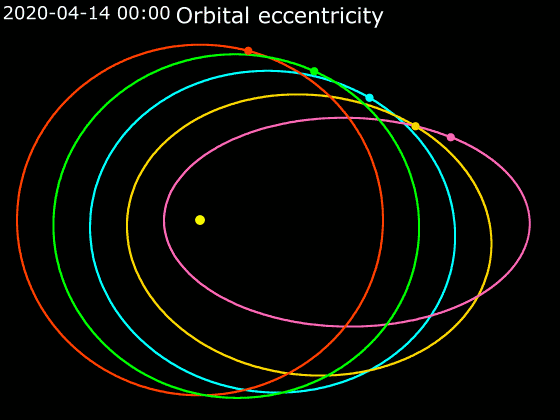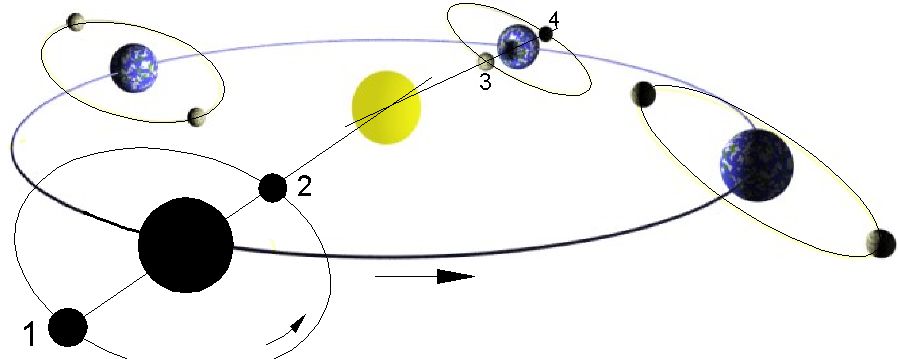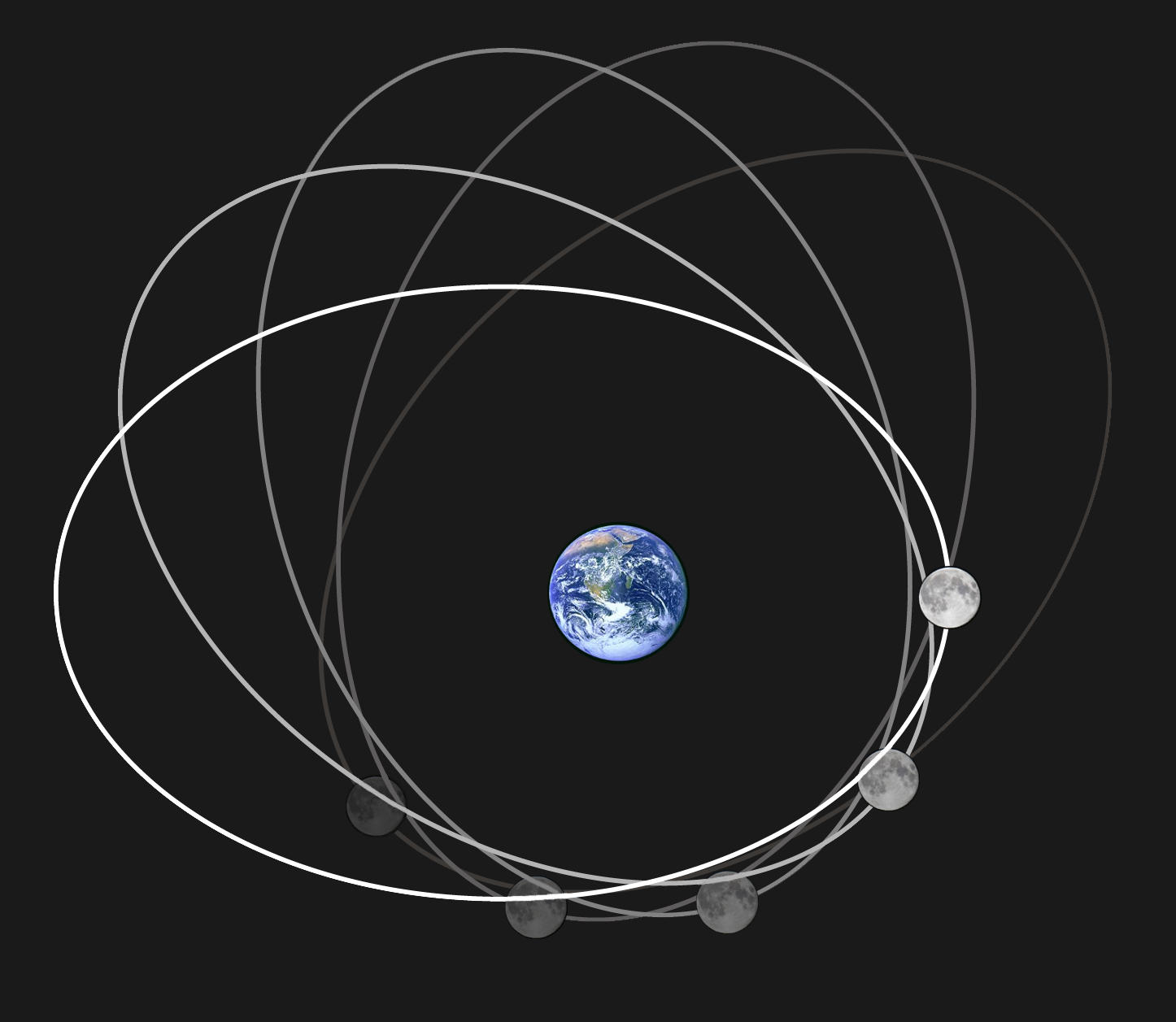|
Perigean Spring Tide
A perigean spring tide is a tide that occurs three or four times per year when a perigee (the point nearest Earth reached by the Moon during its 27.3-day elliptic orbit) coincides with a spring tide (when the Sun, the Moon, and Earth are nearly aligned every two weeks). This has a slight but measurable impact on the spring tide, usually adding no more than a couple of inches. Astronomical causes The Moon's orbit around Earth is elliptical, which causes the Moon to be closer to Earth and farther away at different times. The Moon and the Sun are aligned every two weeks, which results in spring tides, which are 20% higher than normal. During the period of the new moon, the Moon and Sun are on the same side of Earth, so the high tides or bulges produced independently by each reinforce each other (and has nothing to do with the spring season). Tides of maximum height and depression produced during this period are known as spring tide. Spring tides that coincide with the moon's cl ... [...More Info...] [...Related Items...] OR: [Wikipedia] [Google] [Baidu] |
Tide
Tides are the rise and fall of sea levels caused by the combined effects of the gravitational forces exerted by the Moon (and to a much lesser extent, the Sun) and are also caused by the Earth and Moon orbiting one another. Tide tables can be used for any given locale to find the predicted times and amplitude (or " tidal range"). The predictions are influenced by many factors including the alignment of the Sun and Moon, the phase and amplitude of the tide (pattern of tides in the deep ocean), the amphidromic systems of the oceans, and the shape of the coastline and near-shore bathymetry (see '' Timing''). They are however only predictions, the actual time and height of the tide is affected by wind and atmospheric pressure. Many shorelines experience semi-diurnal tides—two nearly equal high and low tides each day. Other locations have a diurnal tide—one high and low tide each day. A "mixed tide"—two uneven magnitude tides a day—is a third regular category. ... [...More Info...] [...Related Items...] OR: [Wikipedia] [Google] [Baidu] |
Perigee
An apsis (; ) is the farthest or nearest point in the orbit of a planetary body about its primary body. The line of apsides (also called apse line, or major axis of the orbit) is the line connecting the two extreme values. Apsides pertaining to orbits around different bodies have distinct names to differentiate themselves from other apsides. Apsides pertaining to geocentric orbits, orbits around the Earth, are at the farthest point called the ''apogee'', and at the nearest point the ''perigee'', like with orbits of satellites and the Moon around Earth. Apsides pertaining to orbits around the Sun are named ''aphelion'' for the farthest and ''perihelion'' for the nearest point in a heliocentric orbit. Earth's two apsides are the farthest point, ''aphelion'', and the nearest point, ''perihelion'', of its orbit around the host Sun. The terms ''aphelion'' and ''perihelion'' apply in the same way to the orbits of Jupiter and the other planets, the comets, and the asteroids of t ... [...More Info...] [...Related Items...] OR: [Wikipedia] [Google] [Baidu] |
Earth
Earth is the third planet from the Sun and the only astronomical object known to Planetary habitability, harbor life. This is enabled by Earth being an ocean world, the only one in the Solar System sustaining liquid surface water. Almost all of Earth's water is contained in its global ocean, covering Water distribution on Earth, 70.8% of Earth's crust. The remaining 29.2% of Earth's crust is land, most of which is located in the form of continental landmasses within Earth's land hemisphere. Most of Earth's land is at least somewhat humid and covered by vegetation, while large Ice sheet, sheets of ice at Polar regions of Earth, Earth's polar polar desert, deserts retain more water than Earth's groundwater, lakes, rivers, and Water vapor#In Earth's atmosphere, atmospheric water combined. Earth's crust consists of slowly moving tectonic plates, which interact to produce mountain ranges, volcanoes, and earthquakes. Earth's outer core, Earth has a liquid outer core that generates a ... [...More Info...] [...Related Items...] OR: [Wikipedia] [Google] [Baidu] |
Moon
The Moon is Earth's only natural satellite. It Orbit of the Moon, orbits around Earth at Lunar distance, an average distance of (; about 30 times Earth diameter, Earth's diameter). The Moon rotation, rotates, with a rotation period (lunar day) that is synchronized to its orbital period (Lunar month#Synodic month, lunar month) of 29.5 Earth days. This is the product of Earth's gravitation having tidal forces, tidally pulled on the Moon until one part of it stopped rotating away from the near side of the Moon, near side, making always the same lunar surface face Earth. Conversley, the gravitational pull of the Moon, on Earth, is the main driver of Earth's tides. In geophysical definition of planet, geophysical terms, the Moon is a planetary-mass object or satellite planet. Its mass is 1.2% that of the Earth, and its diameter is , roughly one-quarter of Earth's (about as wide as the contiguous United States). Within the Solar System, it is the List of Solar System objects by ... [...More Info...] [...Related Items...] OR: [Wikipedia] [Google] [Baidu] |
Elliptic Orbit
In astrodynamics or celestial mechanics, an elliptical orbit or eccentric orbit is an orbit with an eccentricity of less than 1; this includes the special case of a circular orbit, with eccentricity equal to 0. Some orbits have been referred to as "elongated orbits" if the eccentricity is "high" but that is not an explanatory term. For the simple two body problem, all orbits are ellipses. In a gravitational two-body problem, both bodies follow similar elliptical orbits with the same orbital period around their common barycenter. The relative position of one body with respect to the other also follows an elliptic orbit. Examples of elliptic orbits include Hohmann transfer orbits, Molniya orbits, and tundra orbits. Velocity Under standard assumptions, no other forces acting except two spherically symmetrical bodies (m_1) and (m_2), the orbital speed (v\,) of one body traveling along an elliptical orbit can be computed from the vis-viva equation as: :v = \sqrt where: * ... [...More Info...] [...Related Items...] OR: [Wikipedia] [Google] [Baidu] |
Spring Tide
Tides are the rise and fall of sea levels caused by the combined effects of the gravitational forces exerted by the Moon (and to a much lesser extent, the Sun) and are also caused by the Earth and Moon orbiting one another. Tide tables can be used for any given locale to find the predicted times and amplitude (or " tidal range"). The predictions are influenced by many factors including the alignment of the Sun and Moon, the phase and amplitude of the tide (pattern of tides in the deep ocean), the amphidromic systems of the oceans, and the shape of the coastline and near-shore bathymetry (see '' Timing''). They are however only predictions, the actual time and height of the tide is affected by wind and atmospheric pressure. Many shorelines experience semi-diurnal tides—two nearly equal high and low tides each day. Other locations have a diurnal tide—one high and low tide each day. A "mixed tide"—two uneven magnitude tides a day—is a third regular category. ... [...More Info...] [...Related Items...] OR: [Wikipedia] [Google] [Baidu] |
Syzygy (astronomy)
In astronomy, a syzygy ( ; , expressing the sense of σύν ( "together") and ζυγ- ( "a yoke")) is a roughly straight-line configuration of three or more celestial bodies in a gravitational system. The word is often used in reference to the Sun, Earth, and either the Moon or a planet, where the latter is in ''conjunction'' or ''opposition''. Solar and lunar ''eclipses'' occur at times of syzygy, as do ''transits'' and ''occultations''. Main types A syzygy sometimes results in an occultation, transit, or an eclipse. * An occultation occurs when an apparently larger body passes in front of an apparently smaller one. * A transit occurs when a smaller body passes in front of a larger one. ** In the combined case where the smaller body regularly transits the larger, an occultation is also termed a secondary eclipse. * An eclipse occurs when a body totally or partially disappears from view, either by an occultation, as with a solar eclipse, or by passing into the shadow ... [...More Info...] [...Related Items...] OR: [Wikipedia] [Google] [Baidu] |
National Oceanic And Atmospheric Administration
The National Oceanic and Atmospheric Administration (NOAA ) is an American scientific and regulatory agency charged with Weather forecasting, forecasting weather, monitoring oceanic and atmospheric conditions, Hydrography, charting the seas, conducting deep-sea exploration, and managing fishing and protection of marine mammals and endangered species in the US exclusive economic zone. The agency is part of the United States Department of Commerce and is headquartered in Silver Spring, Maryland. History NOAA traces its history back to multiple agencies, some of which are among the earliest in the federal government: * United States Coast and Geodetic Survey, formed in 1807 * National Weather Service, Weather Bureau of the United States, formed in 1870 * United States Fish Commission, Bureau of Commercial Fisheries, formed in 1871 (research fleet only) * NOAA Commissioned Corps, Coast and Geodetic Survey Corps, formed in 1917 The most direct predecessor of NOAA was the Enviro ... [...More Info...] [...Related Items...] OR: [Wikipedia] [Google] [Baidu] |
Orbit Of The Moon
The Moon orbits Earth in the retrograde and prograde motion, prograde direction and completes one orbital period, revolution relative to the March Equinox, Vernal Equinox and the fixed stars in about 27.3 days (a tropical month and sidereal month), and one revolution relative to the Sun in about 29.5 days (a synodic month). On average, the lunar distance, distance to the Moon is about from Earth's centre, which corresponds to about 60 Earth radii or 1.28 light-seconds. Earth and the Moon orbit about their barycentre (common centre of mass), which lies about from Earth's centre (about 73% of its radius), forming a satellite system called the Earth–Moon system. With a mean orbital speed around the barycentre of , the Moon covers a distance of approximately its diameter, or about half a degree on the celestial sphere, each hour. The Moon differs from most Regular moon, regular satellites of other planets in that its orbital plane (astronomy), orbital plane is closer to the ec ... [...More Info...] [...Related Items...] OR: [Wikipedia] [Google] [Baidu] |
New Moon
In astronomy, the new moon is the first lunar phase, when the Moon and Sun have the same ecliptic longitude. At this phase, the lunar disk is not visible to the naked eye, except when it is silhouetted against the Sun during a solar eclipse. The original meaning of the term 'new moon', which is still sometimes used in calendrical, non-astronomical contexts, is the first visible crescent of the Moon after conjunction with the Sun. This thin waxing crescent is briefly and faintly visible as the Moon gets lower in the western sky after sunset. The precise time and even the date of the appearance of the new moon by this definition will be influenced by the geographical location of the observer. The first crescent marks the beginning of the month in the Islamic calendar and in some lunisolar calendars such as the Hebrew calendar. In the Chinese calendar, the beginning of the month is marked by the last visible crescent of a waning Moon. The astronomical new moon occurs by def ... [...More Info...] [...Related Items...] OR: [Wikipedia] [Google] [Baidu] |
Spring (season)
Spring, also known as springtime, is one of the four temperate seasons, succeeding winter and preceding summer. There are various technical definitions of spring, but local usage of the term varies according to local climate, cultures and customs. When it is spring in the Northern Hemisphere, it is autumn in the Southern Hemisphere and vice versa. At the spring equinox, also called the vernal equinox, Daytime (astronomy), days and nights are approximately twelve hours long, with daytime length increasing and nighttime length decreasing as the season progresses until the summer solstice. The spring equinox is in March in the Northern Hemisphere and in September in the Southern Hemisphere, while the summer solstice is in June in the Northern Hemisphere and in December in the Southern Hemisphere. Spring and "springtime" refer to the season, and also to ideas of rebirth, rejuvenation, renewal, resurrection and regrowth. Subtropical and tropical areas have climates better described ... [...More Info...] [...Related Items...] OR: [Wikipedia] [Google] [Baidu] |







